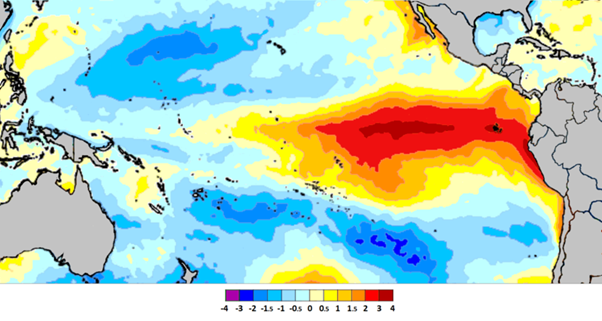Effects of El Nino and its Impact on India's Agricultural Future

A weak El Nino is expected to intensify in the coming years. As the country gears up to feel its effects, here is a blog that details what El Nino is and how it will affect India’s agriculture in the future.
By Topperlearning Expert 11th Sep, 2023 | 06:51 pm
ShareInconsistent rain patterns in the country have been the most widely felt effects of El Nino. Due to poor rainfall in some El Nino is such an unpredictable p parts of the country and extreme rainfall in others, Indian agricultural yields have been affected. Due to crop failure, the produce prices are expected to increase even more in the upcoming months.
So what is the dreaded El Nino, and why is it affecting India to such an extent?
What is El Nino?
El Nino is a Spanish term which means ‘little boy’. It is a natural phenomenon that refers to unusually warm ocean temperatures in the Pacific Ocean, leading to weather changes worldwide. El Nino is not a predictable phenomenon like ocean tides. It occurs at irregular intervals of 2 to 7 years. When the El Nino occurs, the strength and speed of ocean currents, coastal temperature, biodiversity, and weather conditions around the world are affected.
Relation to the Southern Oscillation
The Southern Oscillation is a phenomenon where the air pressure changes over the Pacific Ocean. In the 1930s, scientists found out that the El Nino occurred simultaneously with the Southern Oscillation. So, as the ocean water temperature increased over the Pacific Ocean, its atmospheric pressure also decreased. Thus, the two phenomena were merged to be known as the El Nino-Southern Oscillation (ENSO). Today, El Nino and ENSO are often used interchangeably.
La Nina
The opposite of El Nino is called La Nina, meaning ‘little girl’ where ocean water in the Pacific cools, leading oceanic and atmospheric conditions to change.
Students can watch this YouTube video to understand El Nino and La Nina in detail.
How Does El Nino Occur?
Usually, trade winds blow westwards across the tropical Pacific, which pushes warm surface water towards the western Pacific (bordering Australia and Asia). As warmer water moves westward, cooler water rises to the surface of Peru, Ecuador and Chile. This process is called upwelling. Upwelling supports marine life and major fisheries in Ecuador. It also affects the global climate, with warm temperatures in the western Pacific and cool temperatures along the coast of South America.

However, during El Nino, these westward trade winds grow weak towards the Equator, causing changes in wind speeds and air pressure, resulting in the warm surface water moving eastward (instead of the normal west) to the coastal areas of northern South America. The warm surface water does not allow cooler surface water to rise to the top, disrupting normal upwelling.
Global Weather Changes due to El Nino
Since warm water leads to convection, it increases precipitation. This results in massive rainfall for northern Peru and Ecuador, leading to erosion and coastal flooding. As South America is being lashed with rain, droughts are observed in Australia and Indonesia, leading to poor agricultural yields. It also disrupts global atmospheric circulation, leading to long, harsh, cold winters in North America.
Studies report global warming could double the effects of El Nino in the coming years.
How Does El Nino Affect Indian Weather?
In years without El Nino, the high-pressure Peruvian coasts normally allow moisture-laden winds to travel to the warm, low-pressure Indian Ocean. The winds move further inwards towards the land since the pressure on the land is lower than the ocean. This leads to monsoon rainfall in the country.
El Nino disrupts this pressure distribution, affecting monsoon rainfall in India.
Disrupted Monsoon - Agricultural Damage
In India, farmers sow their crops in early June to benefit from pre-monsoon showers. That is why the El Nino effect is a major cause of concern since it delays the monsoon, brings weak rainfall and creates heatwave conditions, which results in crop failure.

In 2023, starting in July, a weak El Nino effect has been observed in India to date. However, it is also expected to intensify in the coming months. India has already experienced its driest August since 1901 this year. The main cause was the developing El Nino and poor intra-seasonal weather patterns. September is also predicted to yield insufficient rainfall.
Low Crop Production & Rising Prices
In India, monsoon rainfall this year has been irregularly distributed. Some northern states have been in a deficit, while east and northeastern states have received favourable rainfall. Since India gets 75% of its rainfall during monsoon, farmers depend on these showers to grow good agricultural produce.

Due to the insufficient rainfall observed this year, the growth of Kharif crops is expected to be impacted. Cotton, paddy, sugarcane and soybean crops are also expected to suffer. When such poor yields are predicted, it is natural that the prices of these foods will rise in the coming months.
Conclusion
El Nino is a dangerous weather phenomenon that has the potential to wreak havoc across the globe. Its effects include excessive rainfalls in some regions with prevailing droughts in others. India can experience unusually warm winters, while other parts of the globe could experience freezing winters. Poor agriculture and pisciculture yields are observed in most countries during intense El Nino conditions. Students can learn more about El Nino and other such interesting topics on our TopperLearning website, where they can also find a range of study materials for CBSE, ICSE and Maharashtra state boards.
Frequently Asked Questions
Q 1. How can India Prepare for El Nino?
Ans: Since El Nino is such an unpredictable phenomenon, farmers need to undertake the following measures to mitigate the risks of El Nino.
- Conserve water and practice water management.
- Cultivate drought-resistant crops and diversify crop production.
Q 2. Is El Niño good for India or not?
Ans: No, El Nino is not good for India since it can lead to warm winters and dry monsoons, which can impact the country’s agriculture, leading to crop failure and droughts.
Q 3. When was the last El Nino in India?
Ans: Out of the 21 El Ninos years observed post-1950, the last was observed in India during 2018-2019. The country had received below-average rainfall during the monsoon.
More from Science and Technology
Important Resources
- Education Franchisee opportunity
- NCERT Solution
- CBSE Class 9 Mathematics
- NCERT Solutions for class 10 Science
- Sample Papers
- CBSE Class 9 Science
- NCERT Solutions for class 10 Maths
- Revision Notes
- CBSE Class 10 Hindi
- CBSE Class 10 English
- CBSE Class 10 English
- CBSE Class 10 Social Studies
- CBSE Class 10 Science
- CBSE Class 10 Mathematics
- Career In Science After 10
- Career In Commerce After 10
- Career In Humanities/Arts After 10
- NCERT Solutions for Class 10
- NCERT Solutions for Class 11
- Business Studies Class 12 CBSE project





